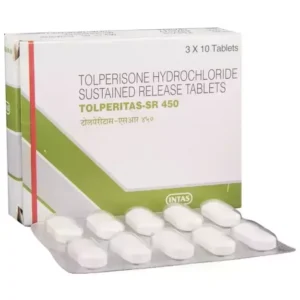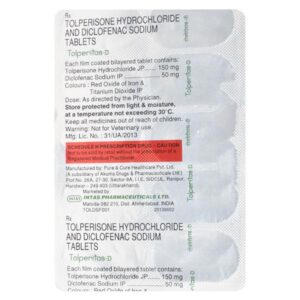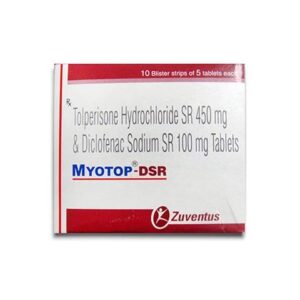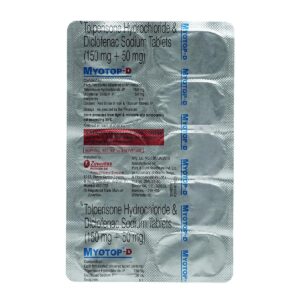DICLOFENAC + TOLPERISONE
Diclofenac: Diclofenac is a nonsteroidal anti-inflammatory drug (NSAID) commonly used to relieve pain and reduce inflammation. It is available in various forms, such as tablets, capsules, gels, creams, and ophthalmic solutions, allowing for different routes of administration.
Mechanism of Action:
Diclofenac inhibits the production of prostaglandins, which are substances involved in inflammation, by blocking the action of an enzyme called cyclooxygenase (COX). By doing so, it reduces pain, swelling, and inflammation in conditions like arthritis, dental pain, migraines, and menstrual cramps.
Use:
Diclofenac is prescribed to treat a variety of conditions, including osteoarthritis, rheumatoid arthritis, ankylosing spondylitis, musculoskeletal disorders, and acute gout. It can also be used to alleviate pain and inflammation after surgical procedures or injuries.
Dose:
The dosage of diclofenac will vary depending on the form of the medication and the specific condition being treated. It is important to follow the instructions provided by the healthcare professional or indicated on the product’s label. Generally, the starting dose for oral diclofenac is 50 mg taken 2-3 times daily. The maximum recommended daily dose is typically 150 mg.
Side Effects:
Common side effects include gastrointestinal complaints like stomach pain, indigestion, heartburn, nausea, and diarrhea. Diclofenac can also increase the risk of gastrointestinal ulcers or bleeding, especially in those with a history of these conditions or elderly patients. Other potential side effects may include headache, dizziness, skin rash, fluid retention, high blood pressure, and kidney problems.
It is crucial to be aware of any potential drug interactions, as diclofenac can interact with other medications, such as certain antidepressants, blood thinners, and diuretics. It is recommended to consult a healthcare professional or pharmacist before starting diclofenac to ensure its safe and effective use.
Tolperisone: Tolperisone is a centrally acting muscle relaxant that is primarily used to treat muscle spasms or spasticity. It is commonly prescribed for conditions such as spasticity associated with cerebral palsy, multiple sclerosis, or spinal cord injury.
The exact mechanism of action of tolperisone is not fully understood. However, it is believed to work by targeting and blocking voltage-gated sodium channels in the central nervous system, which leads to muscle relaxation and decreased muscle spasms.
The usual recommended dose of tolperisone is 50-150 mg three times a day. The dosage may vary depending on the severity of the spasticity and the individual response to the medication. It is important to follow the instructions given by a healthcare professional regarding the dosage and duration of treatment.
Common side effects of tolperisone may include drowsiness, dizziness, dry mouth, headache, nausea, and gastrointestinal upset. These side effects are usually mild and temporary. However, it is advised to inform a healthcare professional if any of these side effects persist or become bothersome. In rare cases, more serious side effects such as allergic reactions, irregular heartbeat, or liver problems may occur. Immediate medical attention should be sought if any severe side effects are experienced.
Tolperisone may interact with certain medications, including those that act on the central nervous system, such as sedatives or opioids. It is important to inform a healthcare professional about all medications being taken to avoid potential drug interactions.
Overall, tolperisone can be an effective muscle relaxant for the treatment of spasms or spasticity. However, it is essential to consult with a healthcare professional for appropriate recommendations and to monitor for any potential side effects.




